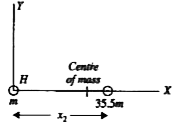Helium atom is two times heavier than hydrogen molecule. At 25∘C, the kinetic energy of He atom is
Double than hydrogen
Same than hydrogen
Four times than hydrogen
Half than hydrogen
The correct Answer is:B
To solve the problem of finding the kinetic energy of a helium atom at 25∘C, we can follow these steps:
Step 1: Understand the relationship between kinetic energy and temperature
The kinetic energy (KE) of a gas is given by the formula:
KE=32RT
where R is the universal gas constant and T is the temperature in Kelvin.
Step 2: Convert the temperature to Kelvin
The temperature given is 25∘C. To convert this to Kelvin, we use the formula:
T(K)=T(°C)+273.15
So,
T=25+273.15=298.15K
Step 3: Identify the value of the gas constant R
The value of the gas constant R is approximately:
R=8.314J/(mol⋅K)
Step 4: Calculate the kinetic energy per mole
Now we can substitute the values of R and T into the kinetic energy formula:
KE=32×8.314J/(mol⋅K)×298.15K
Step 5: Perform the calculation
Calculating the above expression:
KE=32×8.314×298.15
KE≈32×2478.96≈3718.44J/mol
Step 6: Determine the kinetic energy per atom
Since the question asks for the kinetic energy of a single helium atom, we need to convert the kinetic energy per mole to kinetic energy per atom. We can do this by dividing by Avogadro's number (NA≈6.022×1023mol−1):
KEatom=KEmoleNA=3718.44J/mol6.022×1023mol−1≈6.17×10−21J
Final Answer
The kinetic energy of a helium atom at 25∘C is approximately 6.17×10−21J.
---
The kinetic energy (KE) of a gas is given by the formula:
KE=32RT
where R is the universal gas constant and T is the temperature in Kelvin.
The temperature given is 25∘C. To convert this to Kelvin, we use the formula:
T(K)=T(°C)+273.15
So,
T=25+273.15=298.15K
The value of the gas constant R is approximately:
R=8.314J/(mol⋅K)
Now we can substitute the values of R and T into the kinetic energy formula:
KE=32×8.314J/(mol⋅K)×298.15K
Calculating the above expression:
KE=32×8.314×298.15
KE≈32×2478.96≈3718.44J/mol
Since the question asks for the kinetic energy of a single helium atom, we need to convert the kinetic energy per mole to kinetic energy per atom. We can do this by dividing by Avogadro's number (NA≈6.022×1023mol−1):
KEatom=KEmoleNA=3718.44J/mol6.022×1023mol−1≈6.17×10−21J
The kinetic energy of a helium atom at 25∘C is approximately 6.17×10−21J.
Topper's Solved these Questions
Similar Questions
Knowledge Check
Helium atom is two times heavier than a hydrogen molecule. At 289 K, the average kinetic energy of a helium atom is
Atwo times that of a hydrogen moleculeBsame as that of a hydrogen moleculeCfour times that of a hydrogen moleculeDhalf that of a hydrogen molecule.
At certain pressure and 127∘C temperature the mean kinetic energy of hydrogen molecules is 8×10−21J. What is the mean kinetic energy of hydrogen molecules at the same pressure and temperature 27∘C ?
View SolutionThe angular momentum of an electron in hydrogen atom is hπ The kinetic energy of the electron is
View SolutionThe energy of the electron in the ground state of hydrogen atom is −13.6eV. Find the kinetic energy of electron in this state.
View SolutionIn the HCI molecule, the separation between the nuclei of the two atoms is about 1.27Å(1Å=10−10m). Find the approximate location of the c.m of the molecule, given that a chlorine atom is about 35.5 times as massive as a hydrogen atom and nearly all the mass of an atom is concentrated in its nucleus ?
View SolutionA sample of helium and neon gases has a temperature of 300K and pressure of 1.0atm. The molar mass of helium is 4.0g/mol and that of neon is 20.2g/mol.
(a) Find the rms speed of the helium atoms and of the neon atoms.
(b) What is the average kinetic energy per atom of each gas ?
View SolutionIn the HCl molecule, the separation between the nuclei of two atoms is about 1.27 A (1A=10−10m). Find the approximate location of the CM. of the molecule, given that a chlorine atom is about 35.5 times as massive as a hydrogen atom and nearly all the mass of an atom is concentrated in its nucleus.

View SolutionAn α-particle with a kinetic energy of 2.1eV makes a head on collision with a hydrogen atom moving towards it with a kinetic energy of 8.4eV. The collision
View Solution
